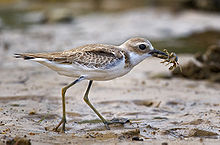- Greater Sand Plover
-
Greater Sand Plover 
Conservation status Scientific classification Kingdom: Animalia Phylum: Chordata Class: Aves Order: Charadriiformes Family: Charadriidae Genus: Charadrius Species: C. leschenaultii Binomial name Charadrius leschenaultii
(Lesson, 1826)The Greater Sand Plover, Charadrius leschenaultii, is a small wader in the plover family of birds. The spelling is commonly given as "Greater sandplover", but the official British Ornithologists' Union spelling is "Greater sand plover".
It breeds in the semi-deserts of Turkey and eastwards through Central Asia. It nests in a bare ground scrape. This species is strongly migratory, wintering on sandy beaches in east Africa, south Asia and Australasia. It is a rare vagrant in western Europe, where it has been recorded as far west as Great Britain, France and Iceland. It has been spotted twice in the Western Hemisphere, the most recent being on May 14, 2009, in Jacksonville, Florida.[2]
This chunky plover is long-legged and thick-billed. Breeding males have grey backs and white underparts. The breast, forehead and nape are chestnut, and there is a black eye mask. The female is duller, and winter and juvenile birds lack the chestnut, apart from a hint of rufous on the head. Legs are greenish and the bill black.
In all plumages, it is very similar to Lesser Sand Plover, Charadrius mongolus. Separating the species may be straightforward in mixed wintering flocks on an Indian beach, where the difference in size and structure is obvious; it is another thing altogether to identify a lone vagrant to western Europe, where both species are very rare. The problem is compounded in that the Middle Eastern race of the greater sand plover is the most similar to the lesser species.
Its food consists of insects, crustaceans and annelid worms, which are obtained by a run-and-pause technique, rather than the steady probing of some other wader groups.
Its flight call is a soft trill.
Its scientific name commemorates the French botanist Jean Baptiste Leschenault de la Tour.
The Greater Sand Plover is one of the species to which the Agreement on the Conservation of African-Eurasian Migratory Waterbirds (AEWA) applies.
Wynnum Esplanade, SE Queensland, Australia
References
- ^ BirdLife International (2004). Charadrius leschenaultii. 2006. IUCN Red List of Threatened Species. IUCN 2006. www.iucnredlist.org. Retrieved on 5 May 2006. Database entry includes justification for why this species is of least concern
- ^ "From Asia by air, rare bird visits Huguenot". Times-Union, Florida. Jacksonville.com. 2009-05-15. http://jacksonville.com/news/metro/2009-05-14/story/from_asia_by_air_rare_bird_visits_huguenot. Retrieved 2009-05-17.
Shorebirds by Hayman, Marchant and Prater ISBN 0-7099-2034-2
- [1] (National Parks and Wildlife Services NSW Australia PDF)
Further reading
- Taylor, P.B. (1987) Field identification of Greater and Lesser Sandplovers, pp. 15-20 in International Bird Identification: Proceeedings of the 4th International Identification Meeting, Eilat, 1st - 8th November 1986 International Birdwatching Centre Eilat
Categories:- IUCN Red List least concern species
- Charadrius
- Birds of Pakistan
- Birds of Europe
- Birds of Turkey
- Migratory birds (Eastern hemisphere)
- Birds of South Australia
- Birds of Western Australia
Wikimedia Foundation. 2010.

